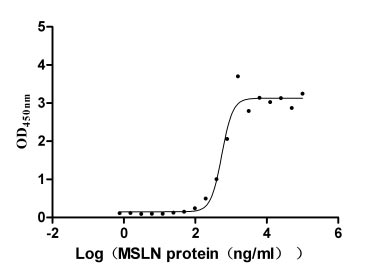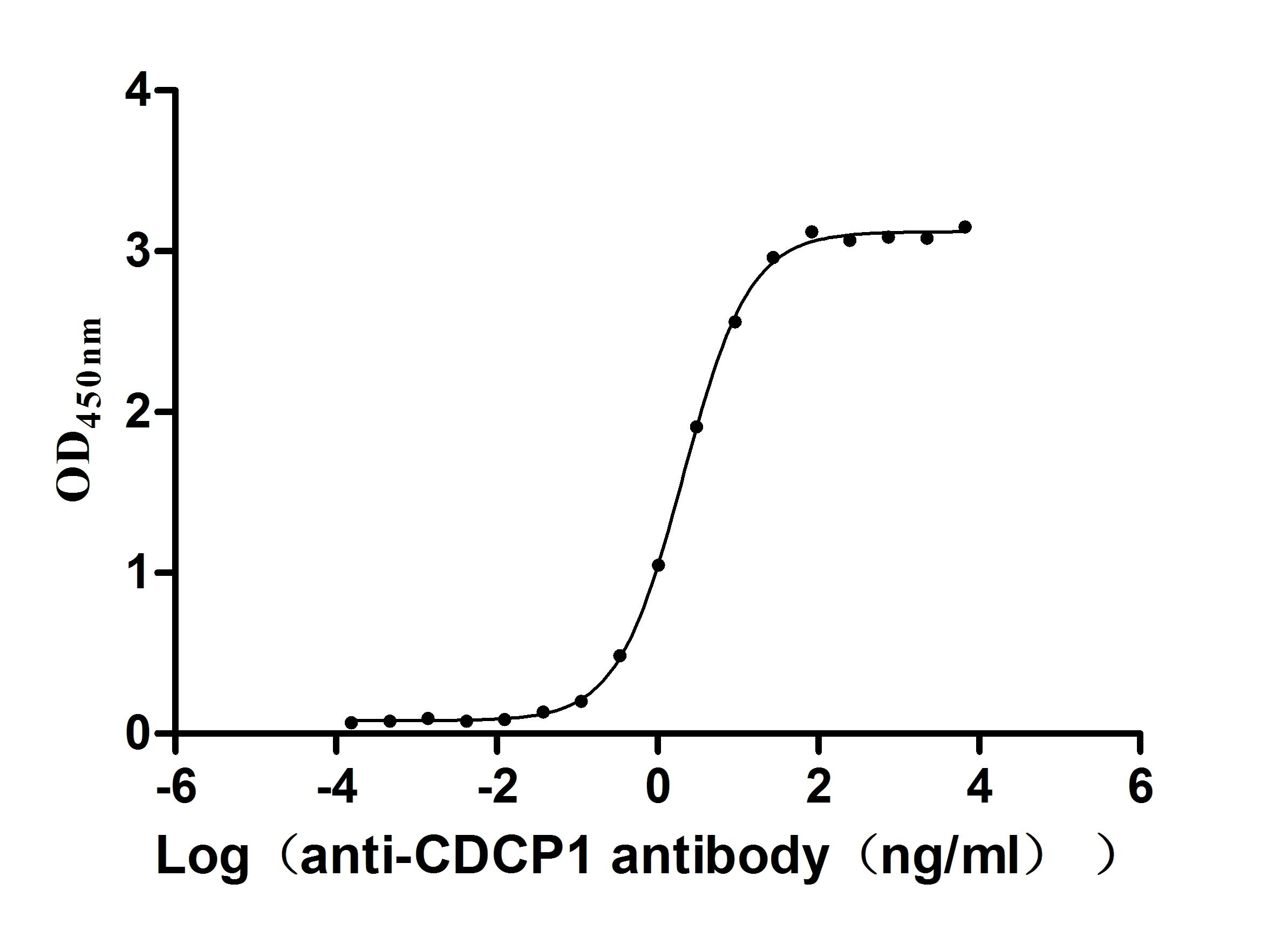Recombinant Human Fatty acid-binding protein (FABP5)
-
货号:CSB-EP007946HUe0
-
规格:¥1344
-
图片:
-
其他:
产品详情
-
纯度:Greater than 90% as determined by SDS-PAGE.
-
基因名:
-
Uniprot No.:
-
别名:CFABP; Cutaneous fatty acid binding protein; DA11; Differentiation associated lipid binding protein LP2; E-FABP; EFABP; Epidermal-type fatty acid-binding protein; FABP5; FABP5_HUMAN; fatty acid binding protein 5 (psoriasis-associated); Fatty acid binding protein epidermal; Fatty acid-binding protein 5; Fatty acid-binding protein; epidermal; Keratinocyte lipid binding protein; KFABP; Klbp; mal1; PA-FABP; PAFABP; Psoriasis associated fatty acid binding protein homolog; Psoriasis-associated fatty acid-binding protein homolog
-
种属:Homo sapiens (Human)
-
蛋白长度:Full Length
-
来源:E.coli
-
分子量:42.2kDa
-
表达区域:1-135aa
-
氨基酸序列MATVQQLEGRWRLVDSKGFDEYMKELGVGIALRKMGAMAKPDCIITCDGKNLTIKTESTLKTTQFSCTLGEKFEETTADGRKTQTVCNFTDGALVQHQEWDGKESTITRKLKDGKLVVECVMNNVTCTRIYEKVE
Note: The complete sequence including tag sequence, target protein sequence and linker sequence could be provided upon request. -
蛋白标签:N-terminal GST-tagged
-
产品提供形式:Liquid or Lyophilized powder
Note: We will preferentially ship the format that we have in stock, however, if you have any special requirement for the format, please remark your requirement when placing the order, we will prepare according to your demand. -
缓冲液:Tris-based buffer,50% glycerol
-
储存条件:Store at -20°C/-80°C upon receipt, aliquoting is necessary for mutiple use. Avoid repeated freeze-thaw cycles.
-
保质期:The shelf life is related to many factors, storage state, buffer ingredients, storage temperature and the stability of the protein itself.
Generally, the shelf life of liquid form is 6 months at -20°C/-80°C. The shelf life of lyophilized form is 12 months at -20°C/-80°C. -
货期:Basically, we can dispatch the products out in 1-3 working days after receiving your orders. Delivery time may differ from different purchasing way or location, please kindly consult your local distributors for specific delivery time.Note: All of our proteins are default shipped with normal blue ice packs, if you request to ship with dry ice, please communicate with us in advance and extra fees will be charged.
-
注意事项:Repeated freezing and thawing is not recommended. Store working aliquots at 4°C for up to one week.
-
Datasheet & COA:Please contact us to get it.
相关产品
靶点详情
-
功能:Intracellular carrier for long-chain fatty acids and related active lipids, such as endocannabinoids, that regulate the metabolism and actions of the ligands they bind. In addition to the cytosolic transport, selectively delivers specific fatty acids from the cytosol to the nucleus, wherein they activate nuclear receptors. Delivers retinoic acid to the nuclear receptor peroxisome proliferator-activated receptor delta; which promotes proliferation and survival. May also serve as a synaptic carrier of endocannabinoid at central synapses and thus controls retrograde endocannabinoid signaling. Modulates inflammation by regulating PTGES induction via NF-kappa-B activation, and prostaglandin E2 (PGE2) biosynthesis during inflammation. May be involved in keratinocyte differentiation.
-
基因功能参考文献:
- FABP5 promotes tumor angiogenesis via activation of the IL6/STAT3/VEGFA signaling pathway in hepatocellular carcinoma. PMID: 29957468
- FABP5 promotes lipolysis of lipid droplets, de novo fatty acid synthesis and activation of NF-kappaB signaling in cancer cells. PMID: 29906613
- Although FABP5 facilitates brain endothelial cell uptake of fatty acids, it has limited effects on brain endothelial cell uptake. PMID: 29247738
- Results show that circulating FABP5 is associated with decreased cholesterol efflux capacity (CEC) and carotid atherosclerosis, suggesting that FABP5 level is a regulatory factor of CEC and a potential biomarker for residual risk of atherosclerosis. PMID: 28303004
- the critical role of FABP5 in activating the TGF-beta signaling pathway during radiation-induced human skin fibrosis PMID: 29215326
- Study identified FABP5 to be involved in the progressive intestinal injury associated with the development of Crohn's Disease complications via their effects on intestinal innate immunity. PMID: 28490445
- Findings show that FABP5 expression is up-regulated in hepatocellular carcinoma (HCC), and provide evidence that that it could play a crucial role of tumor progression, invasion and metastasis in HCC through EMT induction. PMID: 28374947
- A high expression ratio between FABP5 and CRABPII may be related to CP tumor recurrence and ATRA could be a potential therapeutic agent for CP chemotherapy. PMID: 27418530
- Data suggest that antinociceptive agent SBFI-26 binds at a portal site as well as at the canonical site in the substrate pocket of FABP5 and FABP7; only the S form of SBFI-26 binds to both FABP5 and FABP7 in their co-crystal structures; SBFI-26 induces conformational changes in FABP5 and FABP7. PMID: 28632393
- FABP5 plays an important role in the carcinogenesis and metastasis of cervical cancer, and FABP5 may be a novel predictor for prognostic assessment of cervical cancer patients. PMID: 27644245
- FABP5 promoted VEGF expression and angiogenesis through PPARgamma which was activated by fatty acids transported by FABP5. PMID: 26814431
- FABP5 is associated with increased subclinical atherosclerosis PMID: 27055964
- the balance between FABP4 and FABP5 in endothelial cells may be important in regulation of angiogenic versus quiescent phenotypes in blood vessels. PMID: 26625874
- Long chain fatty acids suppress the oncogenic properties of FABP5-expressing carcinoma cells in cultured cells. PMID: 26592976
- silencing of Sp1, c-Myc or FABP5 expression led to a significant decrease in cell proliferation, indicating that up-regulation of FABP5 expression by Sp1 and c-Myc is critical for the proliferation of prostate cancer cells PMID: 26614767
- FABP5 may contribute to the airway remodeling and inflammation in asthma by fine-tuning the levels of CysLTs, which induce VEGF production. PMID: 26020772
- CRABP-II and FABP5 expression patterns are neither related to the tumor grades nor correlated with RA sensitivity. PMID: 25797252
- peripheral uptake of FA via capillary endothelial FABP4/5 is crucial for systemic metabolism and may establish FABP4/5 as potentially novel targets for the modulation of energy homeostasis. PMID: 24244493
- Data indicate that fatty acid-binding protein 5 (FABP5) is tuned to selectively stimulate peroxisome proliferation-activated receptor beta/delta transactivation in response to specific fatty acids based on their structural features. PMID: 24692551
- Both C-FABP and PPARg are suitable as prognostic factors to predict the clinical outcome of prostatic cancer patients. PMID: 24189640
- E-FABP showed high exp ression in NSCLC, and the increased E-FABP expression may involved in the occurrence and development of NSCLC PMID: 23327868
- Our findings establish that FABP5 is critical for mammary tumor development PMID: 23722546
- E-FABP is highly expressed in psoriatic epidermis, and it is mainly localized in stratum spinosum. Psoriatic keratinocytes overexpress E-FABP as compared to the same population in normal epidermis. PMID: 23528210
- FABP5 is significantly overexpressed in intrahepatic cholangiocarcinoma combined lymph node metastasis and is involved in cell proliferation and invasion PMID: 22825302
- E-FABP levels in skin-strippings, but not in serum, were higher in psoriatic patients than in healthy individuals. E-FABP was abundant in patients not only in lesions but also in uninvolved skin. PMID: 23039948
- The most significant discovery of the integrated validation is the down-regulation of FABP5 and PDCD4 in KRAS-activated human tumor bronchial epithelial cells. PMID: 22761399
- High FABP5 is associated with pancreatic ductal adenocarcinoma. PMID: 22010213
- Co-expression of E- and A-FABP is detected in cultured human aortic endothelial cells, which is the critical cellular component in the development of atherosclerosis. PMID: 20452069
- The purpose of this study was to investigate the clinicopathological significance of FABP5 in breast cancer and to evaluate FABP5 as a prognostic marker and a possible novel therapeutic target in breast cancer. PMID: 21356353
- These results validate the differential expressions of SOD2, S100A8 and FABP5 between mycosis fungoides tissues and normal skins. PMID: 20833513
- Overexpression of FABP5 in oral cancer cells increased cell proliferation and invasiveness by increasing expression of MMP-9. PMID: 20040021
- Fatty acid-binding protein 5 and PPARbeta/delta are critical mediators of epidermal growth factor receptor-induced carcinoma cell growth PMID: 20424164
- FABP5 plays a critical role in lipid metabolism in retinal pigment epithetlial cells; knockdown results in accumulation of cellular triglycerides, decreased cholesterol levels, and reduced secretion of apoB100 protein and lipoproteins PMID: 19434059
- FABP5 could be a regulated target of Nurr1. PMID: 19861119
- Solution structure and backbone dynamics PMID: 12049637
- S100A7 expression appears to stabilize epidermal fatty acid binding protein level in keratinocytes PMID: 12839573
- the overexpression of FABP in cultured senescent dermal microvascular endothelial cells is closely related to skin aging. PMID: 15335354
- Metastasis of squamous cell carcinoma of the oral tongue is associated with down-regulation of epidermal fatty acid binding protein (E-FABP). PMID: 16759896
- E-FABP may play a key role in the progress of invasiveness and metastasis in human breast cancer. PMID: 17428383
- study found levels of nuclear & cytoplasmic C-FABP expression in prostate cancer cells were significantly higher than those in normal & benign prostatic hyperplasia tissues & increased C-FABP was significantly associated with reduced patient survival time PMID: 18360704
- Results demonstrated the ubiquitous overexpressions of E-FABP and CAPS in EC and the correlations to the clinicopathologic parameters. CAPS might be a potential prognostic factor for survival in patients with endometrial cancer PMID: 18729184
- epidermal-fatty acid binding protein is upregulated in Human papillomavirus related oral squamous cell carcinoma PMID: 19337991
- fatty acid-binding protein-5, squamous cell carcinoma antigens 2, alpha-enolase, annexin II, apolipoprotein A-I and albumin were detected at a high level in Atopic dermatitis skin lesions, but scarcely in the normal controls PMID: 19339807
显示更多
收起更多
-
亚细胞定位:Cytoplasm. Nucleus. Cell junction, synapse. Cell junction, synapse, postsynaptic density. Secreted.
-
蛋白家族:Calycin superfamily, Fatty-acid binding protein (FABP) family
-
组织特异性:Keratinocytes; highly expressed in psoriatic skin. Expressed in brain gray matter.
-
数据库链接:
HGNC: 3560
OMIM: 605168
KEGG: hsa:2171
STRING: 9606.ENSP00000297258
UniGene: Hs.408061
Most popular with customers
-
Recombinant Human Mucin-16 (MUC16), partial (Active)
Express system: Mammalian cell
Species: Homo sapiens (Human)
-
Recombinant Mouse Transthyretin (Ttr) (Active)
Express system: Mammalian cell
Species: Mus musculus (Mouse)
-
Express system: Mammalian cell
Species: Macaca fascicularis (Crab-eating macaque) (Cynomolgus monkey)
-
Recombinant Human Tomoregulin-2 (TMEFF2), partial (Active)
Express system: Mammalian cell
Species: Homo sapiens (Human)
-
Recombinant Human Tumor-associated calcium signal transducer 2 (TACSTD2), partial (Active)
Express system: Mammalian cell
Species: Homo sapiens (Human)
-
Recombinant Human Myosin regulatory light polypeptide 9 (MYL9) (Active)
Express system: Yeast
Species: Homo sapiens (Human)
-
Recombinant Human Interleukin-2 (IL2) (Active)
Express system: Mammalian cell
Species: Homo sapiens (Human)
-
Recombinant Macaca fascicularis CUB domain containing protein 1 (CDCP1), partial (Active)
Express system: Mammalian cell
Species: Macaca fascicularis (Crab-eating macaque) (Cynomolgus monkey)





















